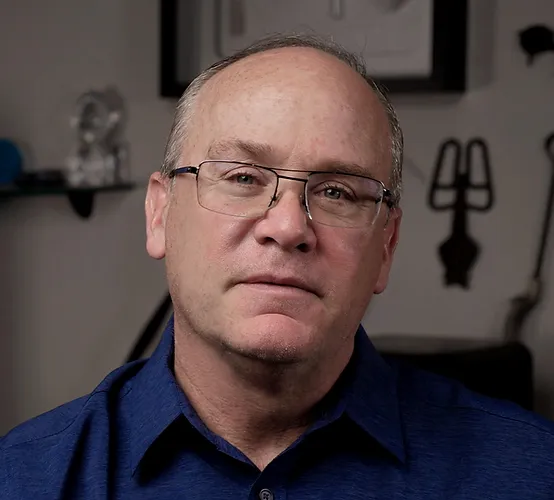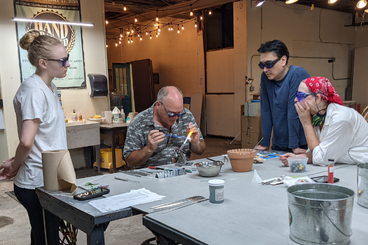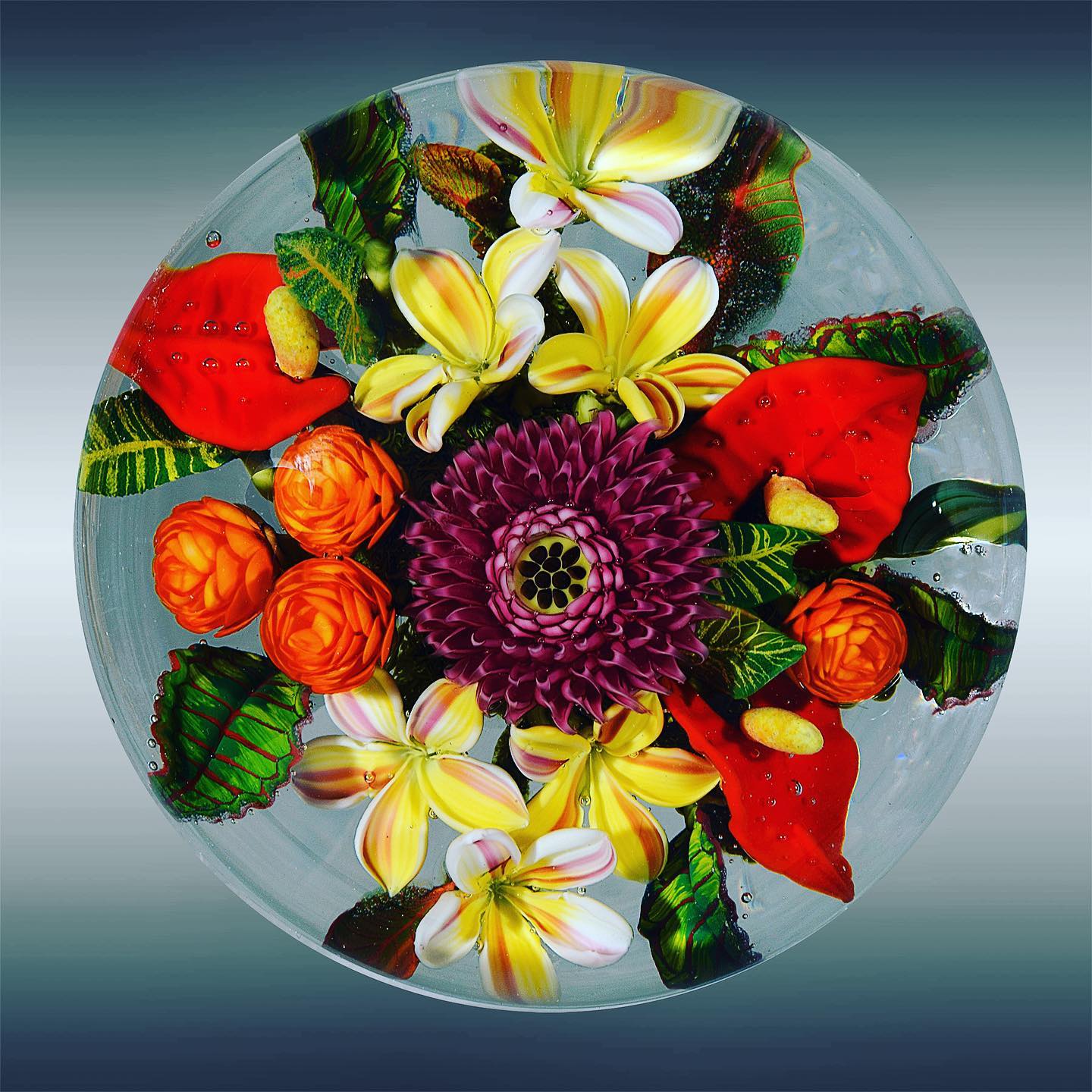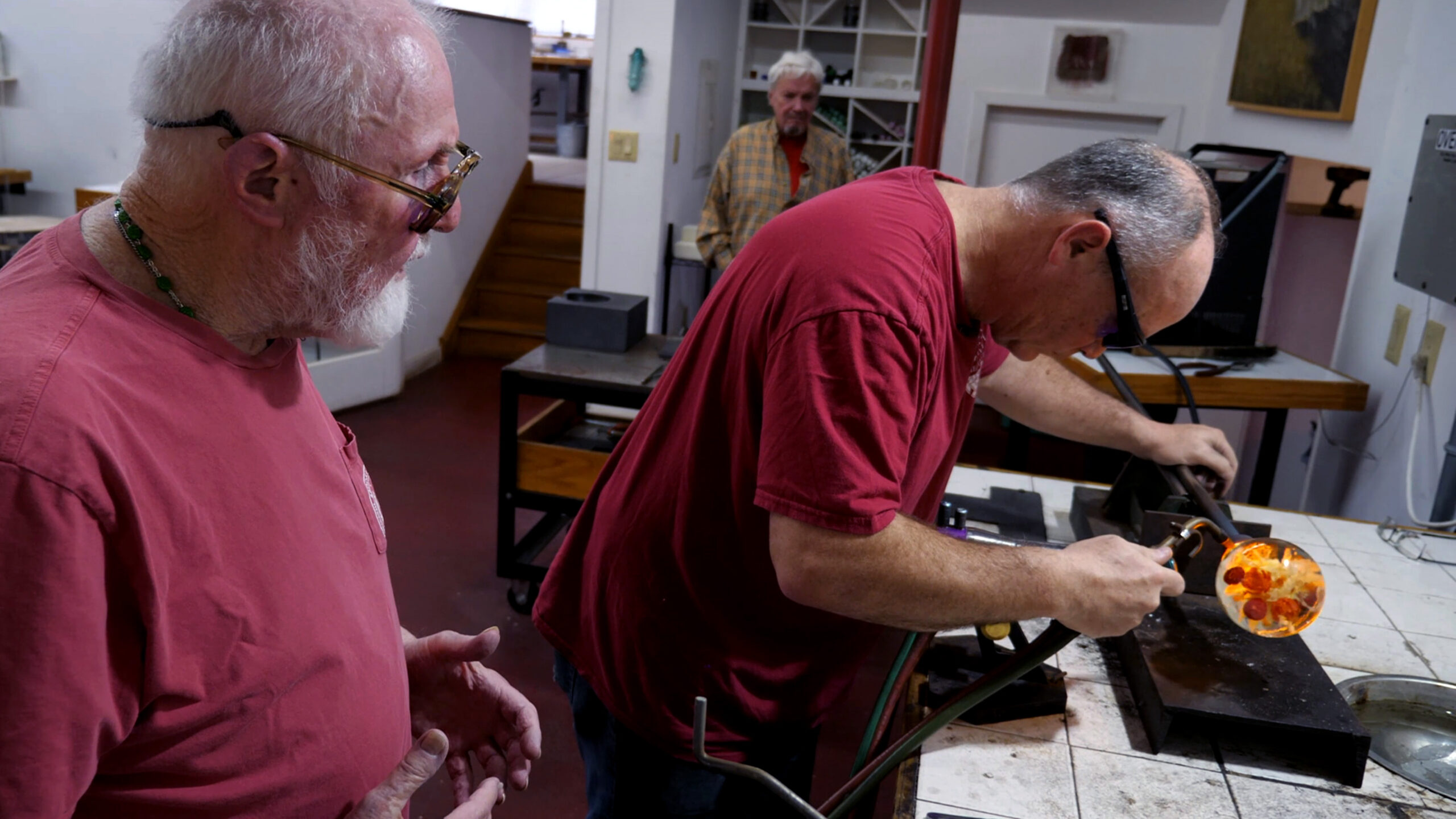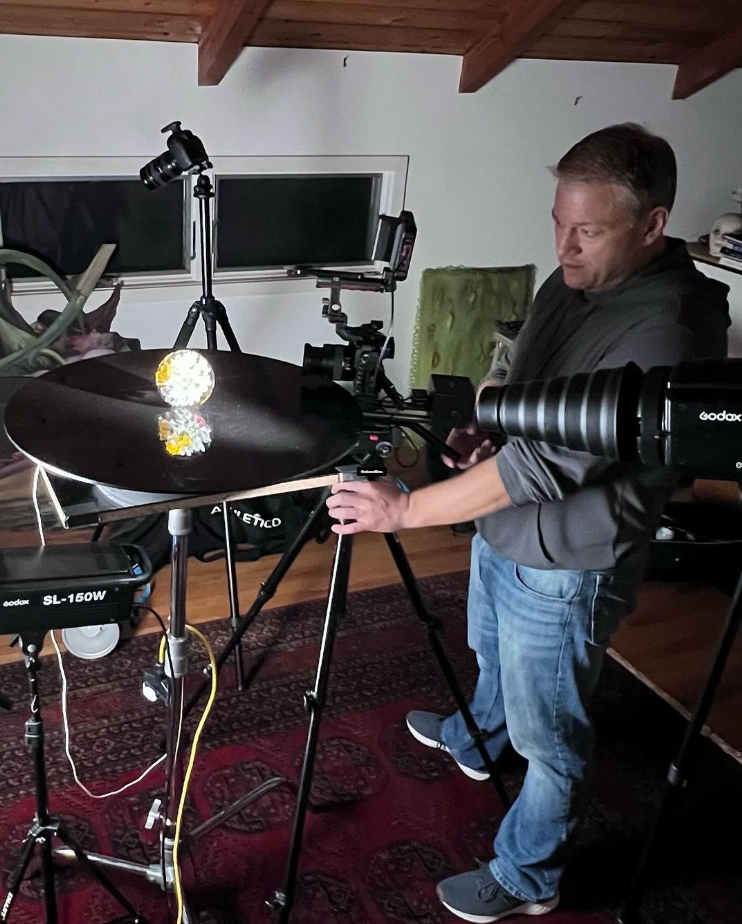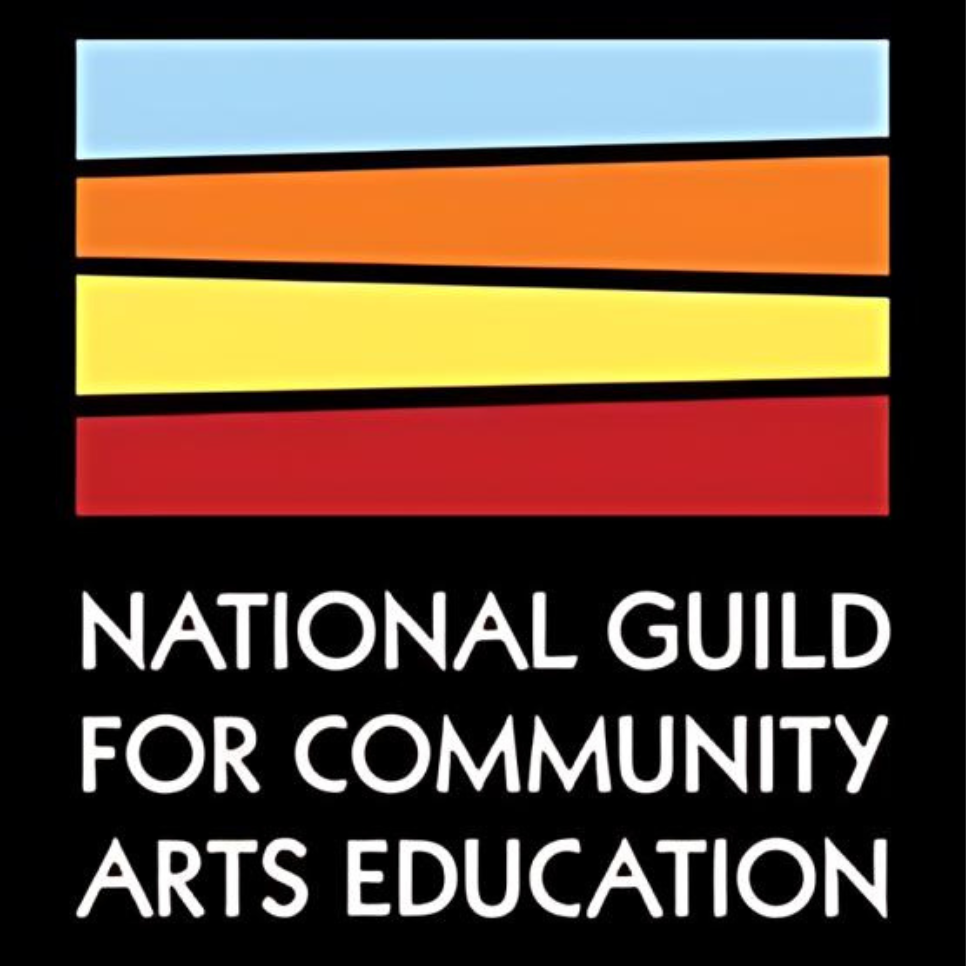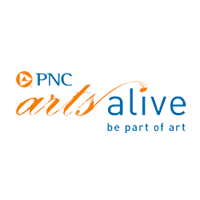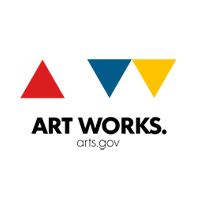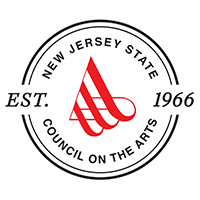Glass Artistry Unveiled: The Journey of David Graeber
Dive into glass artistry with David Graeber, a 35-year glass veteran and the Executive Producer of the Paul J. Stankard: Flower and Flame documentary. In this interview, he unveils the captivating story of his glass journey and his pivotal role in shaping glass programming at Perkins Center for the Arts. Moreover, discover the inspiration behind his connection to his latest project—the documentary chronicling the life and legacy of renowned glass artist Paul J. Stankard. Brace yourself for insights that go beyond the studio, offering a unique glimpse into the life and innovations of a true glass maestro. Whether you’re an aspiring artist seeking guidance or an art enthusiast craving a deeper understanding, this interview promises to enrich your perspective and illuminate the intricate beauty of glass artistry.
Can you introduce yourself and share your role at Perkins Center for the Arts?
Graeber: My name is David Graeber. I’ve been a glass artist for 35 years, and I’m currently a part-time instructor at Perkins Center for the Arts, where I teach glass bead making, glass sculpture, and glass marble making.
You have been a huge influence on the development of Perkins’ glass programming. How did that come about?
Graeber: It was easy. New Jersey’s rich glass tradition and my 35 years of experience led me to see an opportunity at the Perkins Center for the Arts. One day, I called the director, Kahra Buss. Ironically, I think it was only her second week, so she was new. I said, ‘Hey, you don’t know me. My name is David Graber. I’m a glass artist, and you’re going to start offering glass at Perkins.’ There was a little bit of a pause, and she said, ‘Who is this again?’ She was receptive, and we began planning.
Originally aiming for glass blowing, we pivoted to smaller-scale projects like marble making and beadwork due to facility constraints. We have the Collingswood farmers market just outside our doors, so we used that to gauge interest. I ran a few demonstrations during the Farmer’s Market that gathered a lot of public interest. Then we offered a petition asking if people would be interested in this (glasswork) if we offered it at Perkins. I believe we filled 2 1/2 pages worth of signatures, so that was sort of our go-ahead.
I did not do it all by myself. I had the support of the Perkins Education Department, and one of my early students, Kevin Kelly, worked for Diamond Tool, and encouraged Diamond Tool to donate the equipment and glass to get this program started. They were immensely helpful. Kevin Kelly is a former board member, student, and lover of glass. He just loves being creative. So, thanks to Kevin!
How do you find inspiration for your artwork, and why did you choose to focus on paperweights?
Graeber: Well, I studied with Paul Stankard. I learned under his tutelage and was able to master my craft. You know you do something long enough, and you hone your skills, and you get good at it. And I found my own voice within the glass world.
I focus primarily on life experiences and incorporate travel and nature. For example, I did a series of Hawaiian flowers when I went to Hawaii. I did a series on the indigenous flowers of South Jersey; I was on the Batsto Village Citizens Committee based at Batsto Village in Wharton State Forest board for eight years and I did a lot of the native pine barren flowers as well. Nature and the Garden State, I could not have a better model than that.
About the Documentary: Background and Connection to Paul J. Stankard:
Speaking of your mentor, how did you first meet Paul J. Stankard, and what inspired you to document his life, art, and achievements in the Paul J. Stankard: Flower and Flame Documentary?
Graeber: Well, I met Paul through a family member. When I was in high school, I worked for my uncle who had a service station. Paul and my uncle would barter for services when he Paul would stop in and he and I would talk “art.” At the time, I was going to Gloucester County Vocational School for commercial art. I always I knew I wanted to do something with art and pursued it following my graduation from West Deptford High School. I got a job as a graphic artist and did sign painting, and wood carving. I love working with my hands, but I was being told what to make.
One day Paul called me and asked if I would be interested in working for him. I dropped my carving tools and started apprenticing with Paul – it just felt right to me. Sometimes it’s wise to follow your instincts and just go for it. Go for something you enjoy put your time into it and be passionate about it. That’s how I felt and what I did. And here I am 35 years later, still passionate about what I do, and now I’m enjoying sharing more. Now I volunteer a lot more. I volunteered for many programs and organizations including Perkins.
What inspired the documentary?
It came easy because my parents are in their late 80s, and Paul’s in his 80s too. They have told me so many stories over the years, and sometimes I forget. So, I have been audio recording my parents to capture their stories. It occurred to me that they would not be here forever.
It was a straightforward decision to get Paul’s story on film. I wanted to create the most accurate documentary of Paul’s life in glass. His story is unique; he started when there were no tools or manufacturing processes. Today, you can buy anything you need, but he had to figure it all out on his own. I call it the “hard school of knocks” where he figured everything out, from glass compatibility to cutting and cracking. He was inventive, not only inventing a new process called flameworking but also inventing a language to explain it. When you can invent a process and a language, that’s innovation. Today, people take it for granted, but they don’t realize where it all started. He and a few others, known as the “Studio Glass Movement,” broke down the notion that glass was exclusively functional. They improvised experimenting at universities, and that’s how it started.
Why should people come to the event, and how can the community get involved or support it? What impact do you hope it will have?
People should attend the screening to see and celebrate a world-renowned artist from South Jersey. First and foremost, to see this icon and understand how Paul and his work are part of art history, our state’s history, and to hear his story. It gives insight into New Jersey’s glass history, the impact of his education in New Jersey had on his life. This is the most accurate telling of the Paul J. Stankard story, by Director, Dan Collins, who did a phenomenal job. Paul’s life work and passion has impacted the art world and his work is in 70 museums throughout the United States. Telling Paul’s story accurately could have been really hard. Paul had let us in. The “real” Paul was what I hoped Dan would capture. Once Paul started getting acclimated to the camera, he loosened up and that’s when Dan was able to capture authentic footage of Paul working in his studio. The real Paul is what you will see in this film – even the tears.
Stankard: You’re not going to leave that in there. You’re going to cut that out.
Graeber: No. We’re leaving that in.
Stankard: Why?
Graeber: I told Dan we’re leaving that in because that’s the true essence of you. That’s what we’re trying to capture.
Supporting this film ensures that this part of history doesn’t get lost. It also ensures that future glass programs at Perkins will continue to grow to include an upcoming glass program with Veterans. People can support the event by attending and by supporting Perkins Center for the Arts. The mission of the center is to provide life-long learning through arts experiences. If Paul J. Stankard doesn’t represent life-long learning I don’t know who does!
Closing Thoughts: Advice for Aspiring Glass Artists: What advice do you have for aspiring glass artists who may be inspired by you, the documentary, and Paul J. Stankard?
With glass artists or artists in general, just find your voice. The main thing is finding your voice. Use your voice to tell your story through the glass. Express yourself with this medium. Have fun with it and learn. Learn as much as you can about your craft. Find out what inspires you, and what influences you. Bring your life experiences into your work. Don’t get discouraged. You will hit roadblocks. Just push through it. Don’t be afraid to ask for help. Learn under a good teacher and have a good mentor.
Future Aspirations: Are there any new artistic avenues or projects that you’re excited to explore in the coming years?
With the Documentary, I’m looking forward to expanding my audience and promoting. We have a lot in store for this documentary. We’re contacting many universities to add the documentary to their databases.
In conclusion, David Graeber’s journey through the world of glass artistry, his pivotal role in shaping Perkins Center for the Arts, and his executive production of the Paul J. Stankard: Flowers and Flame documentary showcase the transformative power of dedication and passion. As we’ve delved into the intricacies of his craft and the profound impact of mentorship, it’s clear that his story resonates far beyond the studio walls. Join us in celebrating the life and legacy of Paul J. Stankard by securing your tickets now for the “Paul J Stankard: Flower and Flame” documentary screening on February 24th, executive produced by David Graeber. Immerse yourself in an evening of inspiration, creativity, and unparalleled beauty.

